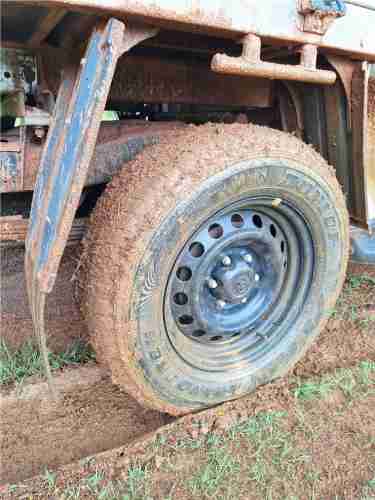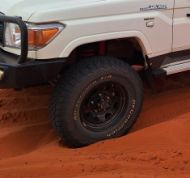

Traction on a 4WD Vehicle
Let’s have a quick chat about what traction means in relation to your 4x4 vehicle and the tracks or situations where you drive. Well, it’s all about being able to maintain momentum, still being able to drive either forwards or backwards. Which means our tyres have sufficient contact or grip with the track surface to enable the car to drive.
You may have read in other blogs that our vehicles are quite heavy and as such contact with the ground shouldn’t be a problem, well that’s kind of the case but as you can see in the photo, when on a soft slippery surface and your tyre tread is full of clay, then traction (forward momentum) can easily be lost.
Soft ground, wet sticky clay, silty material, soft dry sand are all situations where we can easily loose traction and then find ourselves “stuck”. The less “chunky” our tyres are, the quicker they fill up with soil and then they are happy to spin as they loose their grip. We talked about diff locks in another blog, but as you may have read, we can end up in the same situation with all four wheels spinning. Look at 4WD training in Darwin

However, one simple factor can either help us or hinder us in this situation and that is our tyre pressure. In theory, the higher the pressure the least amount of contact we have with the ground surface. So letting our pressure down means we increase the surface area of the tyres which means slightly more contact with the ground. If you have ever been in soft sand and let your tyre down to 20 psi or even slightly less in some cases, the effect can be quite dramatic. Does it mean then that we won’t get stuck in soft sand if we simply let our tyres down, unfortunately not, it is just another “tool” that we can use to assist us in a number of situations.
I often find that many of the vehicles that come to our courses are running very high tyre pressures, quite contrary to the decal that is stuck on the vehicle door pillar. For example, a Prado suggests around 29 psi in the front and around 32 or 34 in the back if you are carrying 2 spares, a fridge, gear and water etc. what we find is that often vehicles present with around 40 psi, or even more in some cases. While you can argue this offers less resistance on the highway and as such is therefore somewhat more fuel efficient, it can be a much harsher ride on rocky or corrugated dirt roads and can be quite common to loose traction in the corners as the tyres are riding higher and create more “bounce” over the bumps and rocks. All of these situations have an impact on the amount of traction available to us at that given time.
Determining a suitable ‘all round” pressure to run in our tyres is therefor important based on our type of vehicle, the weight we normally carry and the type of road conditions we mostly drive on. In other words, what is going to work well on the bitumen and also on the dirt roads we drive on. If we decide to venture onto the beach or into the red dunes that of course is a different situation and as such we will reduce our tyre pressure to suit the conditions. Check out driving courses
If we refer back to the suggested pressure as found on the vehicle door pillar then I believe that is a great starting point for us to gauge how the car handles on the bitumen and a cross section of dirt roads we drive on. This in turn will affect the amount of traction we can maintain across a range of conditions while maintaining the operational integrity of the vehicle.